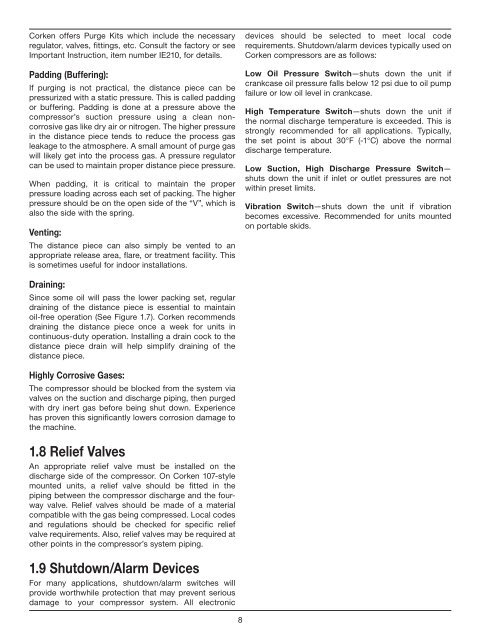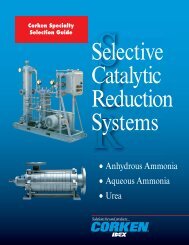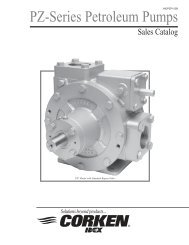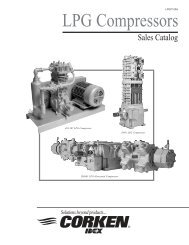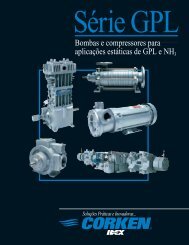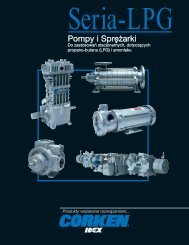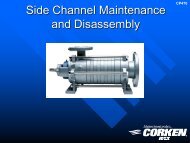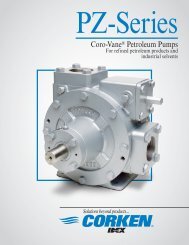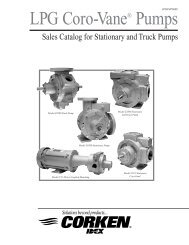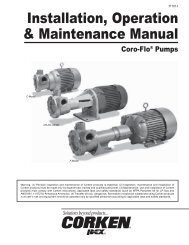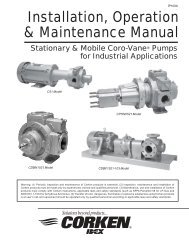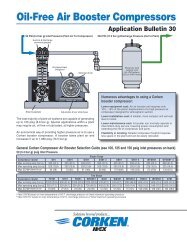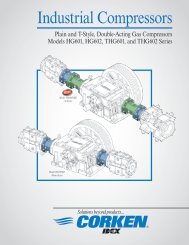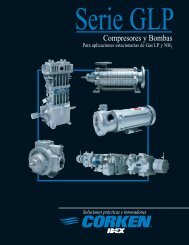Installation, Operation & Maintenance Manual - Corken
Installation, Operation & Maintenance Manual - Corken
Installation, Operation & Maintenance Manual - Corken
You also want an ePaper? Increase the reach of your titles
YUMPU automatically turns print PDFs into web optimized ePapers that Google loves.
<strong>Corken</strong> offers Purge Kits which include the necessary<br />
regulator, valves, fittings, etc. Consult the factory or see<br />
Important Instruction, item number IE210, for details.<br />
Padding (Buffering):<br />
If purging is not practical, the distance piece can be<br />
pressurized with a static pressure. This is called padding<br />
or buffering. Padding is done at a pressure above the<br />
compressor’s suction pressure using a clean noncorrosive<br />
gas like dry air or nitrogen. The higher pressure<br />
in the distance piece tends to reduce the process gas<br />
leakage to the atmosphere. A small amount of purge gas<br />
will likely get into the process gas. A pressure regulator<br />
can be used to maintain proper distance piece pressure.<br />
When padding, it is critical to maintain the proper<br />
pressure loading across each set of packing. The higher<br />
pressure should be on the open side of the “V”, which is<br />
also the side with the spring.<br />
Venting:<br />
The distance piece can also simply be vented to an<br />
appropriate release area, flare, or treatment facility. This<br />
is sometimes useful for indoor installations.<br />
devices should be selected to meet local code<br />
requirements. Shutdown/alarm devices typically used on<br />
<strong>Corken</strong> compressors are as follows:<br />
Low Oil Pressure Switch—shuts down the unit if<br />
crankcase oil pressure falls below 12 psi due to oil pump<br />
failure or low oil level in crankcase.<br />
High Temperature Switch—shuts down the unit if<br />
the normal discharge temperature is exceeded. This is<br />
strongly recommended for all applications. Typically,<br />
the set point is about 30°F (-1°C) above the normal<br />
discharge temperature.<br />
Low Suction, High Discharge Pressure Switch—<br />
shuts down the unit if inlet or outlet pressures are not<br />
within preset limits.<br />
Vibration Switch —shuts down the unit if vibration<br />
becomes excessive. Recommended for units mounted<br />
on portable skids.<br />
Draining:<br />
Since some oil will pass the lower packing set, regular<br />
draining of the distance piece is essential to maintain<br />
oil-free operation (See Figure 1.7). <strong>Corken</strong> recommends<br />
draining the distance piece once a week for units in<br />
continuous-duty operation. Installing a drain cock to the<br />
distance piece drain will help simplify draining of the<br />
distance piece.<br />
Highly Corrosive Gases:<br />
The compressor should be blocked from the system via<br />
valves on the suction and discharge piping, then purged<br />
with dry inert gas before being shut down. Experience<br />
has proven this significantly lowers corrosion damage to<br />
the machine.<br />
1.8 Relief Valves<br />
An appropriate relief valve must be installed on the<br />
discharge side of the compressor. On <strong>Corken</strong> 107-style<br />
mounted units, a relief valve should be fitted in the<br />
piping between the compressor discharge and the fourway<br />
valve. Relief valves should be made of a material<br />
compatible with the gas being compressed. Local codes<br />
and regulations should be checked for specific relief<br />
valve requirements. Also, relief valves may be required at<br />
other points in the compressor’s system piping.<br />
1.9 Shutdown/Alarm Devices<br />
For many applications, shutdown/alarm switches will<br />
provide worthwhile protection that may prevent serious<br />
damage to your compressor system. All electronic<br />
8


